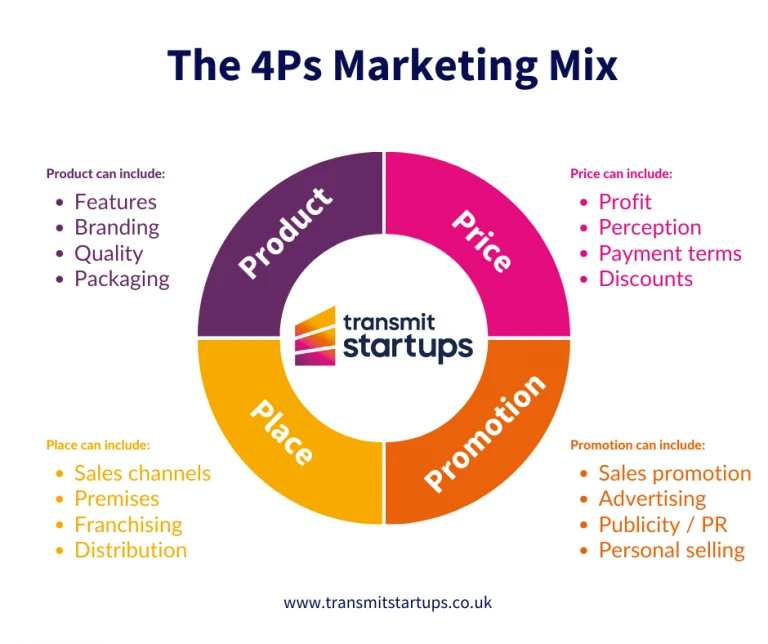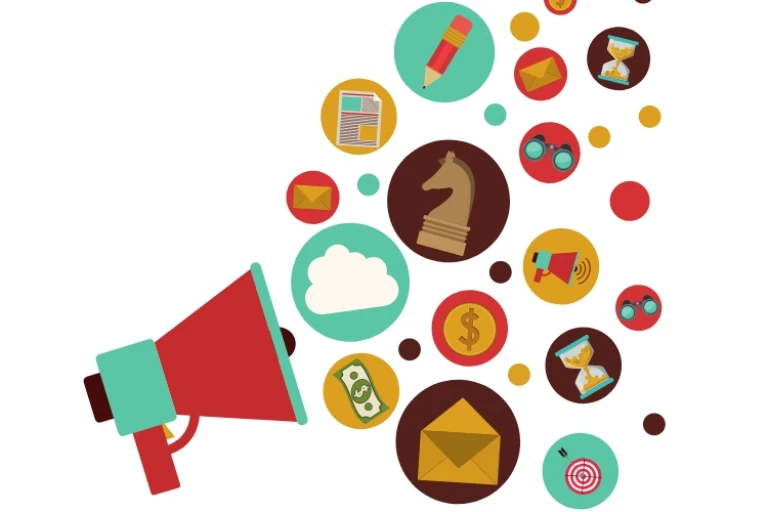Marketing 101: where to start when you’re a startup
HOME / / Marketing 101: where to start when you’re a startup
What does marketing mean?
Marketing is the process of understanding customers’ needs and meeting those needs to make a profit. It includes a mix of activities such as:
market research
product development
promotion
As such, it provides a great framework for thinking about both promoting and selling your products.
People often use the word ‘marketing’ to mean ‘promotion’ or ‘advertising’. But marketing is so much more. Your marketing efforts actually need to start before you’ve put a single item into production!

Applying the marketing mix to your startup
A helpful way to think about marketing is as a mix. The marketing mix is made up of different elements which, when you combine them, create a competitive advantage for your business. There are lots of variations but traditionally there are four key elements.
Product
This is the most important part of the marketing mix. Having a great product or service that people want to buy is the cornerstone for starting a successful business. Market research – such as focus groups and surveys - can help you develop and refine your product by uncovering insights such as:
whether they like the idea of your product
what they think it would be useful for
the problems it can solve in their everyday life
alternatives or improvements to your original concept
what they currently buy instead
Market research can also help you develop your marketing messages; the information you’re going to communicate to potential customers to get them excited about what you offer. Read our blog post about concept testing for early stage startups.
Remember that customers don’t just buy features, they buy benefits, so make sure you highlight both. For example, someone who buys walking boots is buying features like waterproof fabric and sturdy soles. But they’re also buying benefits like a healthy lifestyle, outdoor adventures - and warm feet!
Shifting your mindset from what you can make, to what your customer needs, is the first step to creating a desirable product or service.
Price
How much are you going to charge for your product? At its simplest, you can work out how much it costs to produce an item and add on a percentage for profit.
But savvy startups think more strategically about price. How will perception of your price affect sales? Will your price seem too high for your target customer? Or will it look suspiciously low?
Would people prefer to pay more for a brand that is perceived ‘high end’? Or is there a gap in the market for an affordable option?
Can you use a lower price to undercut competitors and win customers quickly? Or offer a buy-one-get-one-free offer to attract customers without cheapening your brand?
Read our blog post about budgeting, cash flow and pricing to find out more.
Place
Place just means how and where customers buy what you sell.
For product-based businesses, this can mean physical and digital spaces where customers buy your items, as well as distribution channels.
For service-based businesses, it means where people purchase and experience your service (for example, customers of a web-based service experience everything online).
There are so many options to consider and there is no one-size-fits-all. It is important to think about where your ideal customer is likely to shop and what is realistic for your business.
You may want to have a high street shop but starting at your kitchen table and mailing out your products might be more practical and cost-effective in the beginning. Check out our article on the importance of place to your business.
Here are some places / ways you might be able to sell physical products.
Shop / cafe
Having a physical premises on the high street can be a great way to sell products. You’ll catch passing traffic and be able to showcase everything you offer. But overheads can be high.
Pop-up shop
Pop-up shops are a temporary retail space that you take over for a specific short period of time. Often, they spring up around holidays (Halloween, Christmas) to sell products that aren’t in demand all year round. They’re a good way to enjoy the benefits of a high street shop without the long-term commitment.
Market stall
If you dream of channelling your inner Eastender, a market stall can be a fun and affordable way to sell direct to the public.
Specialist fairs
Trade fairs, craft fairs, Christmas fairs etc are all great options for people who want to reach relevant customers or maximise sales at certain times of the year. You can do these alongside other sale efforts, such as direct mail or running an online shop.
Mobile premises
Lots of businesses are mobile. Think coffee carts, street food vendors, pet groomers, car valeters. Investing in a van, truck or even a tuk-tuk can be a great way to catch footfall without investing in a shop. Or to take services direct to your customers.
Online shop (owned by you)
For product-based businesses, selling via your own website is a relatively affordable way to reach your market. And because you own the site, you won’t be subject to commission or selling fees. However, you are responsible for the cost of building and maintaining the site, and you won’t have a readymade market of shoppers and browsers.
Online shop (owned by someone else)
There are lots of platforms where you can be online and selling fast. Gumtree, Facebook, eBay, Amazon, Etsy and others provide a free or low-cost way to promote your products. However, you will be limited in terms of presentation and be bound by their T&Cs.
Vending machines
Traditionally associated with snacks, drinks and sanitary products, vending machines can be used to sell all sorts of items. A recent example is eyelash extension vending machine at a shopping centre, where both shoppers and shop workers might need to dash in the event of an eyelash disaster.

Promotion
Promotion is how you attract the attention of your ideal customer. You’ve already worked out the perfect product to offer, priced it attractively, and sorted out how you’ll sell it. What now? Unfortunately, customers won’t just arrive by chance.
You need to plan a range of promotional activities to let them know who you are, what you do and how you are going to make their lives better. Here are some common approaches to promoting your business. By the way, this list isn’t exhaustive, even though you might feel worn out reading it!
Social media advertising
Social media advertising is an affordable option for most startups, which can get your message in front of a highly targeted audience. But there are lots of options. Think about where you can reach your customers most effectively. Facebook and Instagram might work for selling directly to customers, but Twitter and LinkedIn might be better for reaching out to businesses.
Online advertising
You might consider advertising on webpages your customers are likely to visit (for example, if you sell dog food, you might advertise on the website of a national chain of vets). Or you could pay Google to boost your website to the top of the search results when people search on certain phrases. This is an expensive option for popular keywords (like ‘dog food’) but could be very effective for highly targeted keywords like ‘organic dog food for small breeds’.
Content marketing
The aim of content marketing is to attract customers to you. You do this by creating and sharing content designed to appeal to your ideal customer online. Think about what your ideal customer might be searching for online and publish content that answers their questions. For example, a children’s clothing company might publish blog posts on fun days out for families. Content marketing requires a commitment to producing content consistently and on an on-going basis to build your brand and reputation.
Traditional advertising
Traditional advertising still has a lot to offer small businesses. Offline advertising options include: local press; TV and radio; billboards and public transport; cinemas and shopping malls; and leaflet drops.
Special offers
This covers any kind of special offer that you use to increase sales. BOGOFs, discounts, time-limited offers, competitions… The sort of thing that makes you fill your basket with bargains and things you never knew you needed every time you go to the supermarket.
Social promotion
One way that many small businesses use sales promotion is via social media. If you’ve ever ‘liked, shared and commented’ on a post on Facebook to win a luxury food hamper or weekend glamping, you’ve had first-hand experience of a social sales promotion! In fact, this type of sales promotion is particularly clever because it builds the business’s audience too and improves the reach of future posts. Win-win! Check out our guide to social media for more info.
Influencer marketing
Have you ever bought something because a celeb or blogger uses it? That's influencer marketing in action. It's powerful for a number of reasons: chosen carefully, influencers provide a targeted route to your ideal audience; people are more likely to trust the opinion of a third party than your own marketing; and many people want to be like their favourite influencers.
Direct marketing
Email lists, direct mail and cold calling are all examples of direct marketing. Some of them have a bad rap, but conducted ethically and within legal guidelines, they can be a great way to speak to your target market. You’ll need to consider who you want to target, how you’ll acquire your list, what you’ll offer, and how you’ll receive and process orders.
Word-of-mouth
People are far more inclined to trust what other people say about you, rather than what you say about yourself. So encouraging positive word-of-mouth is a helpful way to build trust in your brand. Positive referrals don’t have to come from influencers with thousands of followers. Two easy ways to get existing customers to become advocates for your brand are:
Online reviews - Ask happy customers if they’d leave a review on your Facebook page or an external site like TripAdvisor (online word-of-mouth is sometimes called word-of-mouse!)
Referral programme – Encourage your current customers to find new ones for you. A good example is when your gym offers you a free month for every friend you introduce.
Public relations
Although PR is traditionally included in the marketing mix, it is actually a discipline in its own right. Find out more at www.cipr.co.uk/content/policy/careers-advice/what-pr
This is just a whistle stop tour of four key elements of marketing. Take a look at the rest of our marketing and sales articles if you want to learn more.

"We’re delighted to be the 2000th loan recipients!"
